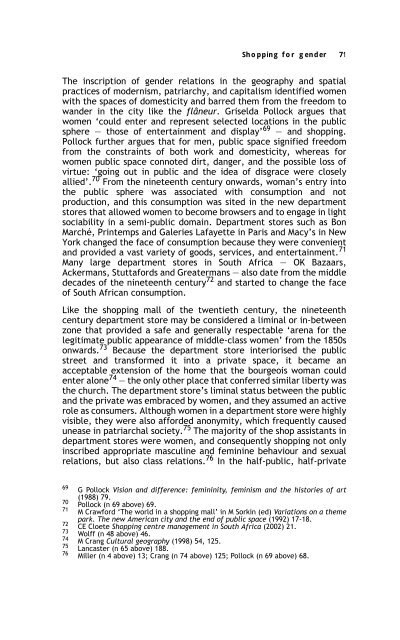Sex, Gender, Becoming - PULP
Sex, Gender, Becoming - PULP
Sex, Gender, Becoming - PULP
You also want an ePaper? Increase the reach of your titles
YUMPU automatically turns print PDFs into web optimized ePapers that Google loves.
Shopping for gender 71<br />
The inscription of gender relations in the geography and spatial<br />
practices of modernism, patriarchy, and capitalism identified women<br />
with the spaces of domesticity and barred them from the freedom to<br />
wander in the city like the flâneur. Griselda Pollock argues that<br />
women ‘could enter and represent selected locations in the public<br />
sphere — those of entertainment and display’ 69 — and shopping.<br />
Pollock further argues that for men, public space signified freedom<br />
from the constraints of both work and domesticity, whereas for<br />
women public space connoted dirt, danger, and the possible loss of<br />
virtue: ‘going out in public and the idea of disgrace were closely<br />
allied’. 70 From the nineteenth century onwards, woman’s entry into<br />
the public sphere was associated with consumption and not<br />
production, and this consumption was sited in the new department<br />
stores that allowed women to become browsers and to engage in light<br />
sociability in a semi-public domain. Department stores such as Bon<br />
Marché, Printemps and Galeries Lafayette in Paris and Macy’s in New<br />
York changed the face of consumption because they were convenient<br />
and provided a vast variety of goods, services, and entertainment. 71<br />
Many large department stores in South Africa — OK Bazaars,<br />
Ackermans, Stuttafords and Greatermans — also date from the middle<br />
decades of the nineteenth century 72 and started to change the face<br />
of South African consumption.<br />
Like the shopping mall of the twentieth century, the nineteenth<br />
century department store may be considered a liminal or in-between<br />
zone that provided a safe and generally respectable ‘arena for the<br />
legitimate public appearance of middle-class women’ from the 1850s<br />
onwards. 73 Because the department store interiorised the public<br />
street and transformed it into a private space, it became an<br />
acceptable extension of the home that the bourgeois woman could<br />
enter alone 74 — the only other place that conferred similar liberty was<br />
the church. The department store’s liminal status between the public<br />
and the private was embraced by women, and they assumed an active<br />
role as consumers. Although women in a department store were highly<br />
visible, they were also afforded anonymity, which frequently caused<br />
unease in patriarchal society. 75 The majority of the shop assistants in<br />
department stores were women, and consequently shopping not only<br />
inscribed appropriate masculine and feminine behaviour and sexual<br />
relations, but also class relations. 76 In the half-public, half-private<br />
69 G Pollock Vision and difference: femininity, feminism and the histories of art<br />
(1988) 79.<br />
70<br />
Pollock (n 69 above) 69.<br />
71 M Crawford ‘The world in a shopping mall’ in M Sorkin (ed) Variations on a theme<br />
park. The new American city and the end of public space (1992) 17-18.<br />
72<br />
CE Cloete Shopping centre management in South Africa (2002) 21.<br />
73 Wolff (n 48 above) 46.<br />
74 M Crang Cultural geography (1998) 54, 125.<br />
75<br />
Lancaster (n 65 above) 188.<br />
76 Miller (n 4 above) 13; Crang (n 74 above) 125; Pollock (n 69 above) 68.
















